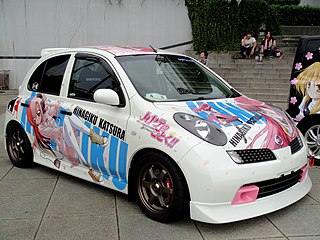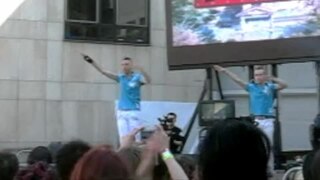 W
WAkishibu-kei is a loosely defined trend from the 2000s that involved an increase of Shibuya-kei influence in anime soundtracks. The term is a portmanteau of "Shibuya-kei" and "Akiba-kei". Both were 1990s cultural movements associated with musical and otaku interests, respectively, and Akishibu-kei was thought to have represented a merging of the two.
 W
WAristocrat is a Japanese street fashion that is inspired by what is thought to have been worn by middle class and higher social status Europeans in the Middle Ages, as well as the upper class in the 19th century. The fashion includes long sleeve blouses and shirts, long skirts, corsetry, and trousers and dresses that are styled similarly for men and women, since it is centred on androgyny and elegance. Most aristocrat fashion takes heavy influence from gothic fashion. Makeup, when worn with the fashion, is on the darker side, may be heavy, and can be worn without regards to gender.
 W
WBōsōzoku is a Japanese youth subculture associated with customized motorcycles. The first appearance of these types of biker gangs was in the 1950s. Popularity climbed throughout the 1980s and 1990s, peaking at an estimated 42,510 members in 1982. Their numbers dropped dramatically in the 2000s with a reported number of under 7,297 members in 2012.
 W
WA cheer screening is a type of film screening associated with Japanese cinema that encourages audience participation through cheering, typically in the form of applause, singing, and the shouting of responses to statements made by characters. Other terms used to describe this category of screening include cheering screening , vocal screening , screaming screening and voice screening .
 W
WCosplay, a portmanteau of "costume play", is an activity and performance art in which participants called cosplayers wear costumes and fashion accessories to represent a specific character. Cosplayers often interact to create a subculture, and a broader use of the term "cosplay" applies to any costumed role-playing in venues apart from the stage. Any entity that lends itself to dramatic interpretation may be taken up as a subject. Favorite sources include anime, cartoons, comic books, manga, television series, and video games. The term is composed of the two aforementioned counterparts - costume and role play.
 W
WDekotora or decotora , an abbreviation for "decoration truck", are extravagantly decorated trucks in Japan. Commonly displaying neon or ultraviolet lights, extravagant paints, and stainless or golden parts, dekotora may be created by workers out of their work trucks for fun, or they may be designed by hobbyists for special events. They are sometimes also referred to as art trucks (アートトラック), ātotorakku)).
 W
WA denpa song (電波ソング) is a type of Japanese music that is intentionally strange and catchy. Common features of denpa songs include intentionally off-key vocals, nonsensical lyrics and an over-the-top tune. Denpa music has grown into a subculture within Japan, forming a significant aspect of otaku culture and has large numbers of dōjin circles and music artists dedicated to denpa music. Denpa is not a specific genre in itself, but rather an umbrella term for various kinds of music.
 W
WFreeter is a Japanese expression for people who lack full-time employment or are unemployed, excluding housewives and students. The average age of Freeters is within the range of 15 to 34 years old.
 W
WFruits was a monthly Japanese street fashion magazine founded in 1997 by photographer Shoichi Aoki. Though FRUiTS covered styles found throughout Tokyo, it is associated most closely with the fashion subcultures found in Tokyo's Harajuku district. The magazine primarily focused on individual styles found outside the fashion-industry mainstream, as well as subcultures specific to Japan, such as lolita and ganguro, and local interpretations of larger subcultures like punk and goth.
 W
WGanguro (ガングロ) is a fashion trend among young Japanese women that started in the mid-1990s, distinguished by a dark tan and contrasting make-up liberally applied by fashionistas.
 W
WGyaru, a Japanese transliteration of the English slang word gal, is a Japanese fashion subculture.
 W
WGyaruo are a sub-group of modern Japanese youth culture. They are the male equivalent of the gyaru. The o suffix that is added to the word, is one reading of the Kanji for male (男). And recently, the kanji for 'dirty' in Japanese (汚), which also has the same reading, is often used by gyaru and gyaruo in a light hearted way, poking fun at themselves because of the reputation that their subculture has gained within society due to their dark skin, hairstyles and often gritty, rough style of clothing that they wear. Gyaruo are characterised by their deep tans, dyed hair, party lifestyle and a liking for all different types of trance music including para-para dancing music, Eurobeat, etc.
 W
WIn Japan, an itasha is a car decorated with images of fictional characters from anime, manga, or video games. The decorations usually involve paint schemes and stickers. Automobiles are called itasha, while similar motorcycles and bicycles are called itansha (痛単車) and itachari (痛チャリ) respectively.
 W
WJapanophilia is the philia of Japanese culture, people and history. In Japanese, the term for Japanophile is "shinnichi" (親日), with "親" equivalent to the English prefix 'pro-' and "日", meaning "Japan". The term was first used as early as the 18th century, switching in scope over time.
 W
WThe Kobe Collection (神戸コレクション) is a fashion event that has been held in Kobe, Japan and other cities during spring and autumn every year since 2002; over 30 brands have participated. It is characteristically a public relations event for consumers, and a chance for young designers to publish their own designs.
 W
WKogal is a Japanese fashion culture that involves schoolgirls wearing an outfit based on Japanese school uniforms but with very short skirts. The short skirts are worn irrespective of the season. The girls may also wear loose socks and scarves, and have dyed hair. The word "kogal" is anglicized from kogyaru, a contraction of kōkōsei gyaru. The girls refer to themselves as gyaru (gals), although this word is applied to several other fashion looks as well.
 W
WLolita fashion is a subculture from Japan that is highly influenced by Victorian clothing and styles from the Rococo period. A very distinctive property of Lolita fashion is the aesthetic of cuteness. This clothing subculture can be categorized into three main substyles: 'gothic', 'classic', and 'sweet'. Many other substyles such as 'sailor', 'country', 'hime' (princess), 'ero' (erotic), 'guro' (grotesque), 'qi' and 'wa', 'punk', 'shiro' (white), 'kuro' (black), and 'steampunk' lolita also exist. This style evolved into a widely followed subculture in Japan and other countries in the 1990s and 2000s and may have waned in Japan as of the 2010s as the fashion became more mainstream.
 W
WNet café refugees , also known as cyber-homeless , are a class of homeless people in Japan who do not own or rent a residence and sleep in 24-hour Internet cafés or manga cafés. Although such cafés originally provided only Internet services, some have expanded their services to include food, drink, and showers. The term was coined in 2007 by a Nippon News Network documentary show NNN Document. The net café refugee trend has seen large numbers of people using them as their homes. The shifting definition of the industry partly reflects the dark side of Japanese economy, whose precarity has been noted since the downfall of the national economy that has lasted for decades.
 W
WPara Para is a synchronized dance that originated in Japan. Unlike most club dancing and rave dancing, there are specific synchronized movements for each song much like line dancing. Para Para is said to have existed since the early 1980s when European countries started selling Italo disco and Euro disco, and in the mid-to late 1970s, new wave and synthpop music in Japan. However, it did not achieve much popularity outside Japan until the late 1990s.
 W
WWotagei (ヲタ芸), also known as otagei (オタ芸), refers to a type of dancing and cheering gestures performed by wota, fans of Japanese idol singers, involving jumping, clapping, arm-waving and chanting slogans. Wotagei is performed at concerts, or at events such as anime and manga conventions and meetings of idol fan groups, and it is thought to have developed from the ōendan, organised cheering squads common at sporting events in Japan. Wotagei is particularly associated with fans of Hello! Project and AKB48 idols, as well as fans of anime and game voice actresses (seiyuu), who often perform theme songs for the series in which they appear.